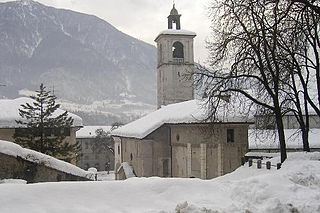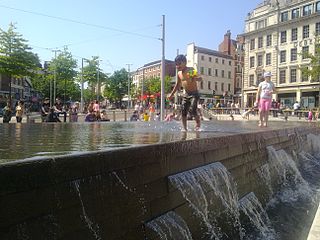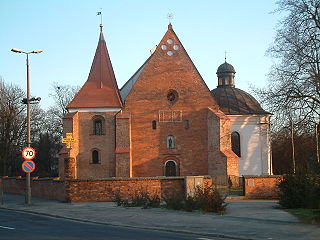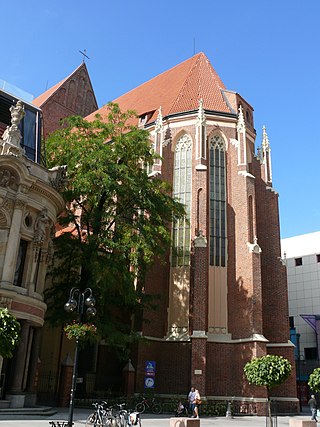
The Grand-Place or Grote Markt is the central square of Brussels, Belgium. It is surrounded by opulent Baroque guildhalls of the former Guilds of Brussels and two larger edifices; the city's Flamboyant Town Hall, and the neo-Gothic King's House or Bread House building, containing the Brussels City Museum. The square measures 68 by 110 metres and is entirely paved.

Izamal is a small city in the Mexican state of Yucatán, 72 kilometres (45 mi) east of state capital Mérida, in southern Mexico.

Henri is Grand Duke of Luxembourg, reigning since 2000. He is the eldest son of Grand Duke Jean and Princess Joséphine-Charlotte of Belgium, as well as a first cousin of King Philippe of Belgium. In 2019, his net worth was estimated around US$4 billion.

Târgu Mureș is the seat of Mureș County in the historical region of Transylvania, Romania. It is the 16th-largest city in Romania, with 116,033 inhabitants as of the 2021 census. It lies on the Mureș River, the second-longest river in Romania.

Feltre is a town and comune of the province of Belluno in Veneto, northern Italy. A hill town in the southern reaches of the province, it is located on the Stizzon River, about 4 kilometres from its junction with the Piave, and 20 km (12 mi) southwest from Belluno. The Dolomites loom to the north of the town.

The Old Market Square is an open, pedestrianised city square in Nottingham, England, forming the heart of the city, and covering an area of approximately 12,000 square metres (130,000 sq ft), or about 3 acres (1.2 ha). It is one of the largest paved squares in the United Kingdom.

Prešeren Square is the central square in Ljubljana, the capital of Slovenia. It is part of the old town's pedestrian zone and a major meeting point where festivals, concerts, sports, political events, and protests take place. It was redesigned according to plans by Edvard Ravnikar from a funnel-shaped to a circular form in 1987–88 and renovated in 2007.

Kraków Old Town is the historic central district of Kraków, Poland. It is one of the most famous old districts in Poland today and was the centre of Poland's political life from 1038 until King Sigismund III Vasa relocated his court to Warsaw in 1596.

Skalica is the largest town in Skalica District in western Slovakia in the Záhorie region. Located near the Czech border, Skalica has a population of around 15,000.

The Place des Martyrs is a garden square in Luxembourg City, in southern Luxembourg. The square lies to the south of the Pétrusse valley, in the quarter of Gare. It is colloquially known as the Rose Garden, on account of the red roses that dominate the garden's floriculture.

Luxembourg City Hall is the city hall of Luxembourg City, in southern Luxembourg. The city hall is the centre of local government, including being used as the private office of the Mayor of Luxembourg City. Because of its position in Luxembourg's capital, it regularly hosts foreign dignitaries. It is located on the southwestern part of Place Guillaume II, the main square in the centre of the city.

The Bernardine church and monastery in Lviv, Ukraine, is located in the city's Old Town, south of the market square. It was designed by Paolo Dominici. The monastery along with the church of St. Andrew now belong to the Order of St. Basil the Great of the Ukrainian Greek Catholic Church.

The Royal-Imperial Route in Poznań is a tourist walk running through the most important parts of the city and presenting the history, culture and identity of Poznań. The Route leads in a westward direction, from The Church of St. John Jerusalem behind the Wall to the Church of the Sacred Heart of Jesus and St. Florian.

The Place d'Armes is a square in Luxembourg City in the south of the Grand Duchy of Luxembourg. Centrally placed in the old town, it attracts large numbers of locals and visitors, especially in the summer months. It originally served as a parade ground for the troops defending the city.

Rock um Knuedler is a rock festival held every summer in the centre of Luxembourg City. Founded in 1991 when Luxembourg held the presidency of the European Union, it was originally designed for local groups but since 1995 it has also been a popular venue for foreign bands and artists. Performances by some 12 groups take place each year on two stages erected on Place Guillaume II, also known as Knuedler. Admission is free, attracting audiences of up to 10,000.

Tourism is an important component of the national economy of Luxembourg, representing about 8.3% of GDP in 2009 and employing some 25,000 people or 11.7% of the working population. Despite the 2008–2012 global recession, the Grand Duchy still welcomes over 900,000 visitors a year who spend an average of 2.5 nights in hotels, hostels or on camping sites. Business travel is flourishing representing 44% of overnight stays in the country and 60% in the capital, up 11% and 25% between 2009 and 2010. Published by the World Economic Forum in March 2011, the Travel and Tourism Competitiveness Report puts Luxembourg in 15th place worldwide, up from 23rd place in 2009.

The Church of Sts. Dorothea, Wenceslaus, and Stanislaus is a Gothic Roman Catholic church in the southern part of Wrocław's Old Town.

Altmünster Abbey was a Benedictine monastery on the Plateau Altmünster, between the Fishmarket and Clausen areas of Luxembourg City.

Trinity Church, also known as the Protestant Church, has been used since 1817 for Protestant services in the city of Luxembourg. It is located on Rue de la Congrégation in the old town.
The city walls of Warsaw are walls around Warsaw Old Town. They are composed of two lines: inner and outer, with several gates round the city. Originally raised between the 13th and 16th centuries, then rebuilt in 1950–1963, partly later. The best-preserved fragments of the fortification are those parallel to Podwale street, from the Warsaw Royal Castle to the Barbican and further to the Vistula Embankment.




















